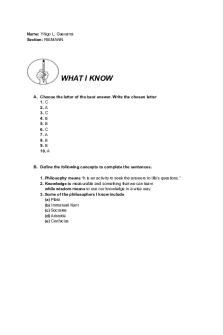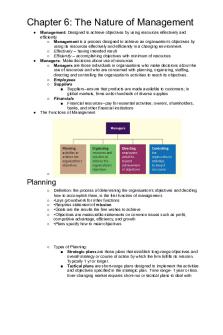The Nature of Communication PDF

| Title | The Nature of Communication |
|---|---|
| Course | Humanities and Social Sciences |
| Institution | University of Perpetual Help System DALTA |
| Pages | 4 |
| File Size | 73.7 KB |
| File Type | |
| Total Downloads | 108 |
| Total Views | 181 |
Summary
COMMUNICATION...
Description
The Nature of Communication Definition of Communication Communication is a process by which people send messages or exchange ideas or thoughts with one another in a verbal or nonverbal manner. It originates from the Latin term, communicare; meaning to share, to unite, to join, or to have things in common. Principles and Characteristics of Communication Communication is a schemata-driven. Communication makes you send to or receive messages from somebody by activating your schemata, experiences, or background knowledge that you have stored in your brain since your early developmental stages. You begin with what you have already stocked in your brain or with what you have already known or understood about the subject matter of the communicative act. 2. Communication is interpretative act. The only person who knows the exact or full meaning of the message transmitted is the sender or speaker. Thus, the role of the receiver or listener is just to interpret, infer, guess the meaning of things appealing to his senses of hearing. 3. Communication does not guarantee a direct or automatic link between two minds. What you know and feel about your environment stay inside yourself except when you decide to convey these people around you. Unless you engage yourself in communicative act with a person, you will never know this man’s views, thoughts and feeling about his world. 4. Communication is active, powerful, or forceful. Messages have varied effects on all participants in any communicative event. Eliciting different meanings or reactions, these messages are prone to changes brought about by sociological, institutional, ideological, cultural, and other environmental elements. 5. Communication is symbolic. Symbols, signs, or marks like letters, words, sentences, graphs, pictures, and other concrete objects represent or stand for ideas that you intend to convey verbally. 6. Communication is irreversible.
Upon giving a statement, instantly your words create an impact on the listener. Any attempt of repeating, retrieving, or reversing what you’ve said doesn't work to bring back the initial effects of the original or the first saying of the statement. 7. Communication is contextual. An exchange of views, ideas, or feelings doesn’t involve the sender and the receiver, but also other aspects of communication setting like time, place, topic, occasion, purpose, and manner of communication. 8. Communication is developmental or progressive. To communicate is to go through the different stages of language learning that begins from birth to elementary, high school and college levels. It is not a one time l earning towards communicative competence. 9. Communication is a process. Several stages of communication takes place when people exchange or share ideas with one another. Each stage involves elements with different functions. 10. Communication is ethical. Any communicative event is expected to apply rules, moral values, and beliefs agreed upon by societal members. To maintain harmonious relationships, practice ethical communication, instead of wrongful communication. 11. Communication is influenced by media and technology. Using modern electronic communication devices, an exchange of ideas occurs just in seconds or minutes regardless of the distance between or among the participants. The process of Communication Communication process has the following stages or steps to show how elements involved in this process play their roles in a cyclical or recurrent pattern. Stage 1: Conceptualizing Stored in this portion of your body are your concepts, ideas, images, experiences, beliefs, attitudes, values about people things, places, or events in this universe. Stage 2: Encoding You have to think of codes or symbols to embody, signify or represent these concepts or ideas you want to communicate to others. Stage 3: Transmitting
Through verbal and nonverbal symbols you chose to represent your ideas, you send or forward messages or ideas to the people involved in the communicative event. Stage 4: Receiving The message or idea represented by verbal or nonverbal symbols and transmitted by the sender or speaker reach the receiver or listener through his sense of hearing and seeing; the deaf or blind through his sense of touch. Stage 5: Decoding Your early personality developmental stages, these schemata, concepts, or background knowledge about your world are your bases in interpreting, guessing, or giving meanings to the symbols appealing to your sensory experience. Stage 6: Responding Your reactions is either positive or negative based on the meanings signified by the symbols or ideas expressed by words, gestures, facial expressions, voice intonation or tone. Stage 7: Verification To make sure that your acts of exchanging of views or ideas with other people really cater to their interests, likes or dislikes, you have to verify or check the effects of your communication on them. Models of Communication Each communication model stresses one or two aspects or components of communication. Despite their differences, all models are the same in conveying fundamental knowledge or meaning of communication in which is an act of exchanging thoughts and feelings about people, places, or things. 1. Linear Model of Communication Introduced in 1940 by Claude Shannon and Warren Weaver, this model reflects Aristotelian view of communication, stresses the idea that the process of communication involves several components. 2. Interactive model of communication Studies of Paul Watz Lawich, Janet Beavin, and Don Jackson in 1967. 3. Social-Cultural model As its name suggests, this model stresses the strong influence of social and cultural elements like customs, traditions, beliefs, attitudes, clothing styles, or thinking patterns on a group of people communicating with one another. 4. Transactional model of communication
This communication model has strong similarities with the Interactive Model because it has these core communication components – Speaker, Listener, Message, Situation, Channel, Feedback, Interference – that serve as the core components of the interactive Model. Seatwork: Directions: If you were to illustrate what you think is the best communication model, how would it look like? Orally, explain or describe your drawing to your classmates....
Similar Free PDFs

The Nature of Communication
- 4 Pages

The Nature of Morality
- 18 Pages

The Nature of Crime
- 17 Pages

The Pencil Of Nature
- 11 Pages

The Nature of Crime
- 12 Pages

THE NATURE OF SCIENCE
- 8 Pages

The Nature of the Firm
- 22 Pages

THE Nature OF Labour Market
- 2 Pages

The nature and functions of the law
- 78 Pages

Coase ON THE Nature OF THE FIRM
- 5 Pages
Popular Institutions
- Tinajero National High School - Annex
- Politeknik Caltex Riau
- Yokohama City University
- SGT University
- University of Al-Qadisiyah
- Divine Word College of Vigan
- Techniek College Rotterdam
- Universidade de Santiago
- Universiti Teknologi MARA Cawangan Johor Kampus Pasir Gudang
- Poltekkes Kemenkes Yogyakarta
- Baguio City National High School
- Colegio san marcos
- preparatoria uno
- Centro de Bachillerato Tecnológico Industrial y de Servicios No. 107
- Dalian Maritime University
- Quang Trung Secondary School
- Colegio Tecnológico en Informática
- Corporación Regional de Educación Superior
- Grupo CEDVA
- Dar Al Uloom University
- Centro de Estudios Preuniversitarios de la Universidad Nacional de Ingeniería
- 上智大学
- Aakash International School, Nuna Majara
- San Felipe Neri Catholic School
- Kang Chiao International School - New Taipei City
- Misamis Occidental National High School
- Institución Educativa Escuela Normal Juan Ladrilleros
- Kolehiyo ng Pantukan
- Batanes State College
- Instituto Continental
- Sekolah Menengah Kejuruan Kesehatan Kaltara (Tarakan)
- Colegio de La Inmaculada Concepcion - Cebu





